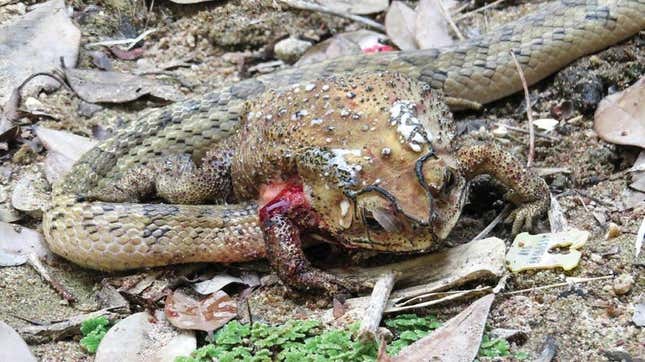
Biologists in Thailand have documented a behavior never seen before in snakes, in which the limbless reptiles eviscerated and consumed the organs of living toads.
Snakes, as a general rule, swallow their prey whole, but as new research published in the science journal Herpetozoa points out, the small-banded kukri snake of Thailand is an exception.
Using their specialized front teeth, the kukri snakes (Oligodon fasciolatus) tear a hole through the bellies of large poisonous toads, then insert their entire heads into the cavity to “pull out and eat the organs one by one, while the prey is still alive!” wrote Henrik Bringsøe, an amateur herpetologist from Denmark and the first author of the new study, in a blog post penned for Pensoft Publishers.
Kukri snakes are small-to-medium snakes that are harmless to humans. Well, mostly harmless; their teeth are designed for cutting rather than puncturing, and they’re capable of inflicting large tearing wounds on animals, including humans. The name “kukri” itself is derived from the curved kukri knives used by Gurkhas soldiers, according to the paper. Moreover, their bites come with an anticoagulant agent that causes wounds to bleed for hours, which likely helps these snakes as they leisurely feast on toad eviscera.

The victim is the Asian black-spotted toad (Duttaphrynus melanostictus), which can grow to 8 inches long (20 cm). These toads are common but poisonous, secreting a white toxin from glands located on their neck and back. This poison could be the reason for the highly unorthodox feeding strategy employed by the kukri snakes, though the researchers aren’t entirely certain.
Bringsøe and his colleagues witnessed these grim scenes on three different occasions in Loei province of northeast Thailand, all of which were caught on camera. The documented episodes happened in August 2016, April 2020, and June 2020. In some cases, the toads tried to resist and break free, but none survived. These sessions weren’t short, lasting upwards of “a few hours,” depending on which organs were selected by the snakes, wrote Bringsøe. An excerpt from the paper describes the case from 2016:
The snake used its enlarged [front] teeth to slit through the left side of the abdomen just underneath the left front leg. Its head was swung from side to side as it managed to cut through the skin of the toad. Slowly the snake inserted its head into the left side of the toad’s abdomen and subsequently it pulled out organs like liver, heart, lung and part of the gastrointestinal tract (at least the full stomach and full small intestines). During the process of retraction, the head was moved in different directions with a partly open mouth, allowing the teeth to cut the organs into smaller pieces which were then swallowed.
In all cases, the snakes fed exclusively on the toads’ organs, leaving their empty carcasses behind. Similar feeding patterns were observed in the other two examples, but, as seen in the second case, sometimes the toads fought back.
During this battle, a badly wounded toad was observed to spray its poison “like a fine mist,” with some of it landing on the snake’s head, according to the study. This caused the snake to pull away and rub its face against some dead leaves and rocks to remove the toxin from its eyes and mouth. This happened twice during the struggle, and at one point the toad even managed to escape by jumping into a nearby pond and hiding under a log for nearly 30 minutes. But it was not to be, as the snake, once recovered, relocated its prey and finished the job.

As noted, this unusual feeding behavior may be an adaptation that prevents the snake from ingesting the toad’s toxin, but a fourth observation complicates this hypothesis. In this case, an adult kukri snake attacked a smaller juvenile toad belonging to the same species—and consumed it whole. As the authors speculate, it’s possible that younger toads are less toxic than adults or that kukri snakes are immune to the poison.
“At present, we cannot answer any of these questions, but we will continue to observe and report on these fascinating snakes in the hope that we will uncover further interesting aspects of their biology,” wrote Bringsøe in the blog post.
Grim study, but other species do equally macabre things, including shrikes who impale their living prey on thorns (and even barbed wire) and shrews who use their venom to paralyze mice, which are then devoured slowly. And in one bizarre example, falcons have been observed to imprison tiny birds in the crevasses of rocks in an attempt to keep them fresh for a future meal.